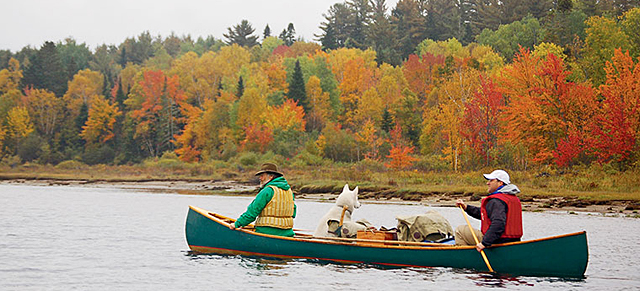
I’m very excited this week to divulge my favorite regional outfitters, the small guys who have no budget to advertise and create a catalog, but know their locale like the back of their hand. In fact, many of the larger outfitters hire these guys to take their groups out. First up,
Mahoosuc Guide Service, based in Newry, Maine. The best introduction to Mahoosuc is to simply share the intro of the article I wrote about
paddling the Maine Woods for Sierra Magazine.
Wearing a felt hat, plaid shirt, and a graying beard, Kevin Slater sits in the back of his canoe, looking as comfortable as most men his age are reclining in a Lazy-Boy. His stroke is short, fluid, with a short inward snap at the end to steer him exactly where he needs to be in a river dotted with boulders. In front of him sits his faithful companion, a peach-colored husky named Kara. Several months from now, when the maples grow barren and the pines are heavy with snow, Kara will be in a raucous team of her fellow Yukon brethren pulling a dogsled through the melt. But now, at the peak of fall foliage in northern Maine, with the maples and poplars on the hillside radiant with splashes of yellow, plum, and purple, Kara can rest and she does just that with her head jutting out over the edge.
Like the paddles we hold in our hands, the 17 ½ and 20-foot long wood and canvas canoes we sit in were all created by Slater. It takes more than 120 hours of work to carve one of these delicately ribbed beauties out of northern white cedar and cherry wood, using only native varieties.
“I was taught that you can find anything you need to make in these woods,” says Slater.
His skilled craftsmanship was passed down from his mentor, who Slater refers to simply as the “Old Timer.” As in, “after paddling the entire Allagash, the Old Timer told me to go to the local store and get ten days of supplies. I was going to go back upstream on my own. That’s how I learned how to canoe these rivers.”
Slater is the latest in a long line of teachers and students who learned to live in the Maine woods and to navigate the maze of blue waterways, a seemingly countless number of lakes, rivers, streams, and ponds that branch off in every direction to form this capillary system deep in the forest. The baton, (or in this case, a paddle) has been passed over the generations from the Wabanaki Indians to European fur traders to a growing legion of naturalists with familiar names like Emerson and Thoreau to the timbermen of the 20th century, and lastly the recreational paddlers like you and me who yearn to get lost in a timeless bubble far away from the hyperkinetic mindset of modernity.
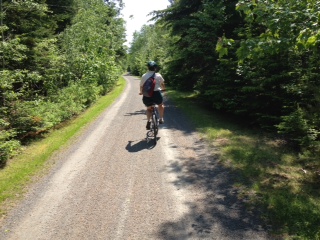 The Bay of Fundy and Fundy National Park might be the better known of the two national parks in New Brunswick, but Kouchibouguac (pronounced Koo-she-boo-gwac) is just as loved in the province. Only an hour north of Moncton, it’s a must-stop on the Acadian Route, especially for bikers and beach lovers. The national park has 60 km of hard-packed gravel trails, not unlike the carriage path trails in Maine’s Acadia National Park. This includes a sweet 6 km singletrack mountain biking route along Major Kollock Creek.
The Bay of Fundy and Fundy National Park might be the better known of the two national parks in New Brunswick, but Kouchibouguac (pronounced Koo-she-boo-gwac) is just as loved in the province. Only an hour north of Moncton, it’s a must-stop on the Acadian Route, especially for bikers and beach lovers. The national park has 60 km of hard-packed gravel trails, not unlike the carriage path trails in Maine’s Acadia National Park. This includes a sweet 6 km singletrack mountain biking route along Major Kollock Creek. 
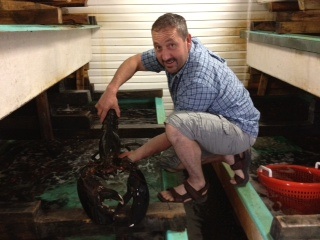 All it takes is a one-minute conversation with Dr. Mathieu Duguay to understand how he persuaded the finest harpsichordists and cellists in Amsterdam, New York, and Berlin to come perform Bach in a 300-seat seat church on the island of Lamèque. A genuine lover of music, Duguay knows the most talented period performers of the day and has flown them over to New Brunswick to play in a church, acclaimed for its exceptional acoustics and vibrantly painted interior. Today, the
All it takes is a one-minute conversation with Dr. Mathieu Duguay to understand how he persuaded the finest harpsichordists and cellists in Amsterdam, New York, and Berlin to come perform Bach in a 300-seat seat church on the island of Lamèque. A genuine lover of music, Duguay knows the most talented period performers of the day and has flown them over to New Brunswick to play in a church, acclaimed for its exceptional acoustics and vibrantly painted interior. Today, the 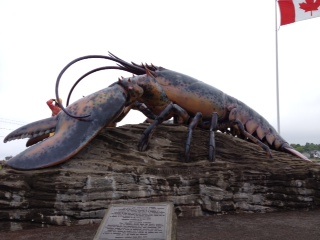 All you have to do is take one look at the 35-foot long lobster sculpture at the entrance to the seaside town of Shediac to know that you’ve reached the crustacean capital of the Maritimes. You’ll soon pass a lobster plant and many restaurants offering lobster rolls and PEI mussels. Yet, the best way to have a taste of lobster is aboard the
All you have to do is take one look at the 35-foot long lobster sculpture at the entrance to the seaside town of Shediac to know that you’ve reached the crustacean capital of the Maritimes. You’ll soon pass a lobster plant and many restaurants offering lobster rolls and PEI mussels. Yet, the best way to have a taste of lobster is aboard the 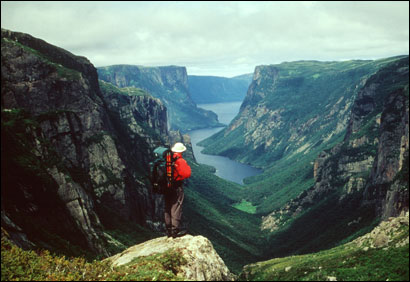 In the summer of 2002, I had the pleasure of backpacking the stunning Long Range Traverse, on assignment for Backpacker magazine. Nestled within Newfoundland’s Gros Morne National Park, a designated UNESCO World Heritage Site because of its unique combination of quartzite rock and wetland terrain, the Long Range Mountains could very well be the one of the last remnants of pristine wilderness within a three-hour flight of New York and Boston. There were no manicured trails with requisite wooden signs showing us which way to go and exact mileage to get there. The Long Range Traverse is a 35 kilometer semi-circular route where topo maps and a compass are a necessity to find your way among the web of caribou paths. Indeed, caribou and moose far outnumbered the four other backpackers we saw on the four-day traverse, averaging one hiker per day.
In the summer of 2002, I had the pleasure of backpacking the stunning Long Range Traverse, on assignment for Backpacker magazine. Nestled within Newfoundland’s Gros Morne National Park, a designated UNESCO World Heritage Site because of its unique combination of quartzite rock and wetland terrain, the Long Range Mountains could very well be the one of the last remnants of pristine wilderness within a three-hour flight of New York and Boston. There were no manicured trails with requisite wooden signs showing us which way to go and exact mileage to get there. The Long Range Traverse is a 35 kilometer semi-circular route where topo maps and a compass are a necessity to find your way among the web of caribou paths. Indeed, caribou and moose far outnumbered the four other backpackers we saw on the four-day traverse, averaging one hiker per day.  I’m very excited this week to divulge my favorite regional outfitters, the small guys who have no budget to advertise and create a catalog, but know their locale like the back of their hand. In fact, many of the larger outfitters hire these guys to take their groups out. First up,
I’m very excited this week to divulge my favorite regional outfitters, the small guys who have no budget to advertise and create a catalog, but know their locale like the back of their hand. In fact, many of the larger outfitters hire these guys to take their groups out. First up,